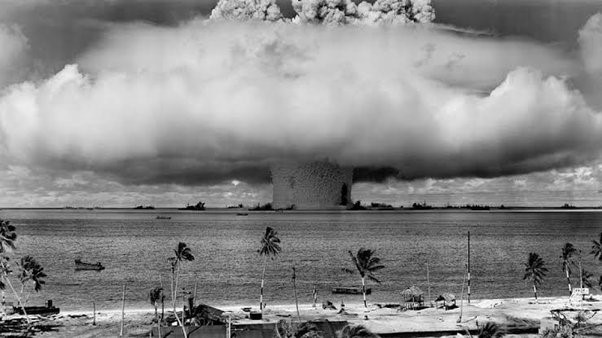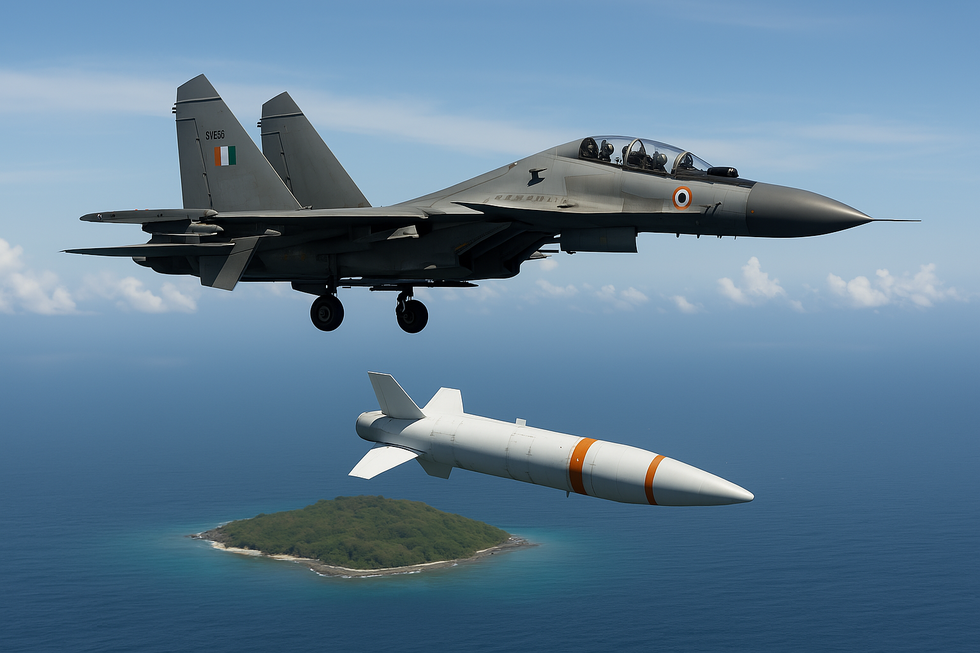Description

Disclaimer: Copyright infringement not intended.
Context
- Announcing to the world that India had entered an elite group of nations whose members possessed nuclear capabilities, India conducted its first nuclear tests on May 18, 1974, in Pokhran, Rajasthan, as part of the ‘Smiling Buddha’ operation.
About
- Operation Smiling Buddha or Operation Happy Krishna (MEA designation: Pokhran-I) was the assigned code name of India's first successful nuclear bomb test.
- Pokhran-I was also the first confirmed nuclear weapons test by a nation outside the five permanent members of the United Nations Security Council.
- After this, a series of nuclear tests were carried out in 1998 under the name Pokhran-II
- A nuclear device was detonated, with a yield of 12-13 kiloton of TNT, on May 18, 1974.
- Pokhran, an army test range located in the desert of western Rajasthan, was chosen.
Domestic reaction
- Then Prime Minister Indira Gandhi termed the event a “peaceful nuclear explosion”, perhaps to assuage the rest of the world and particularly the members of the United Nations Security Council’s permanent five (or P-5) members.
- The test caused an immediate revival of Indira Gandhi's popularity, which had flagged considerably from its heights after the 1971 war.
International reaction
- While India continued to state that the test was for peaceful purposes, it encountered opposition from many quarters.
- The Nuclear Suppliers Group (NSG) was formed in reaction to the Indian tests to check international nuclear proliferation.
- The NSG decided in 1992 to require full-scope IAEA safeguards for any new nuclear export deals, which effectively ruled out nuclear exports to India, but in 2008 it waived this restriction on nuclear trade with India as part of the Indo-US civilian nuclear agreement.
Pakistan
- Pakistan did not view the test as a "peaceful nuclear explosion", and cancelled talks on normalisation of relations.
- The chairman of the Pakistan Atomic Energy Commission, Munir Ahmed Khan, said that the test would force Pakistan to test its own nuclear bomb.
Canada and United States
- The plutonium used in the test was created in the CIRUS reactor supplied by Canada and using heavy water supplied by the United States.
- Both countries reacted negatively, especially in light of then ongoing negotiations on the Nuclear Non-Proliferation Treaty and the economic aid both countries had provided to India.
- Canada froze nuclear energy assistance for the two heavy water reactors then under construction.
- The United States concluded that the test did not violate any agreement and proceeded with a June 1974 shipment of enriched uranium for the Tarapur reactor.
Subsequent nuclear explosions
- Despite many proposals, India did not carry out further nuclear tests until 1998.
- After the 1998 general elections, Operation Shakti (also known as Pokhran-II) was carried out at the Pokhran test site, using technology designed and built over the preceding two decades.

India and Nuclear Weapons
- Although India has not released any official statements about the size of its nuclear arsenal, recent estimates suggest that India has around 200 nuclear weapons.
- India is a member of three multilateral export control regimes — the Missile Technology Control Regime, Wassenaar Arrangement and Australia Group.
- It has signed and ratified the Biological Weapons Convention and the Chemical Weapons Convention.
- India is also a subscribing state to the Hague Code of Conduct.
- India has signed neither the Comprehensive Nuclear-Test-Ban Treaty nor the Nuclear Non-Proliferation Treaty, considering both to be flawed and discriminatory.
- India previously possessed chemical weapons, but voluntarily destroyed its entire stockpile in 2009 — one of the seven countries to meet the OPCW extended deadline.
- India maintains a "no first use" nuclear policy and has developed a nuclear triad capability as a part of its "Minimum Credible Deterrence" doctrine.
Chemical weapons
- In 1992, India signed the Chemical Weapons Convention (CWC), becoming one of the original signatories of the CWC in 1993, and ratified it on 2 September 1996.
Nuclear weapons
- Nehru pursued a policy of formally foregoing nuclear weapons while at the same time constructing a civilian nuclear energy program, and by extension the capability to make a nuclear bomb.
- India built its first research reactor in 1956 and its first plutonium reprocessing plant by 1964.
- India's nuclear programme can trace its origins to March 1944 and its three-stage efforts in technology were established by Homi Jehangir Bhabha when he founded the nuclear research centre, the Tata Institute of Fundamental Research.
- India's loss to China in the 1962 war provided the impetus for developing nuclear weapons as a means of deterring potential Chinese aggression.
India's no-first-use policy
- The Indian government asserts that nuclear weapons are solely for deterrence and that India will pursue a policy of "retaliation only".
- India "will not be the first to initiate a nuclear first strike, but will respond with punitive retaliation should deterrence fail" and that decisions to authorise the use of nuclear weapons would be made by the Prime Minister or his 'designated successor(s)'.
- India's Strategic Nuclear Command was formally established in 2003.
- The joint services SNC is the custodian of all of India's nuclear weapons, missiles and assets.
- It is also responsible for executing all aspects of India's nuclear policy.
- However, the civil leadership, in the form of the CCS (Cabinet Committee on Security) is the only body authorised to order a nuclear strike against another offending strike.
Indian nuclear triad
- Air-launched nuclear weapons: The Mirage 2000 of the Indian Air Force is believed to be assigned the nuclear strike role.
- Land-based ballistic missiles: Agni missiles are used for delivering nuclear weapons.
- Sea-based ballistic missiles: The Indian Navy has developed two sea-based delivery systems for nuclear weapons, completing Indian ambitions for a nuclear triad.
- The first is a submarine-launched system consisting of ballistic missile submarines of the Arihant class.
- The second is a ship-launched system based around the short range ship-launched Dhanush ballistic missile.
International response
- India is not a signatory to either the NPT or the Comprehensive Nuclear-Test-Ban Treaty (CTBT), but did accede to the Partial Nuclear Test Ban Treaty in 1963.
- India is a member of the International Atomic Energy Agency (IAEA), and four of its 17 nuclear reactors are subject to IAEA safeguards.
- In August 2008, the International Atomic Energy Agency (IAEA) approved safeguards agreement with India under which the former will gradually gain access to India's civilian nuclear reactors.
- In September 2008, the Nuclear Suppliers Group granted India a waiver allowing it to access civilian nuclear technology and fuel from other countries.
- The implementation of this waiver makes India the only known country with nuclear weapons which is not a party to the NPT but is still allowed to carry out nuclear commerce with the rest of the world.
- Since the implementation of the NSG waiver, India has signed nuclear deals with several countries including France, United States, Mongolia, Namibia, Kazakhstan and Australia while the framework for similar deals with Canada and the United Kingdom are also being prepared.
Domestic legislation
- India has a number of laws in whole or in partial measure that deal with the regulation of weapons of mass destruction.
- They include the Weapons of Mass Destruction and their Delivery Systems (Prohibition of Unlawful Activities) Act of 2005.
|
PRACTICE QUESTION
Q) The Indian government asserts that nuclear weapons are solely for deterrence and that India will pursue a policy of "retaliation only". Discuss the salient features of India’s no-first-use policy and the international response to it. (250 words)
|

https://indianexpress.com/article/explained/explained-history/operation-smiling-buddha-nuclear-first-test-pokhran-history-8616714/
















